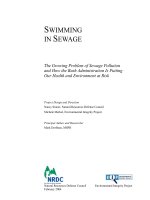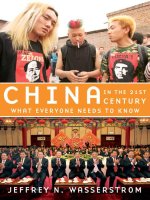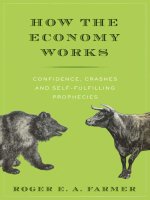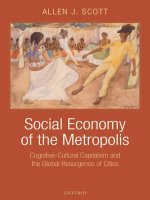- Trang chủ >>
- Khoa Học Tự Nhiên >>
- Vật lý
how the economy works confidence crashes and self-fulfilling prophecies apr 2010
Bạn đang xem bản rút gọn của tài liệu. Xem và tải ngay bản đầy đủ của tài liệu tại đây (1.28 MB, 208 trang )
How the Economy Works
This page intentionally left blank
How the Economy
Works
Confidence, Crashes and
Self-Fulfilling Prophecies
ROGER E. A. FARMER
1
2010
3
Oxford University Press, Inc., publishes works that further
Oxford University’s objective of excellence
in research, scholarship, and education.
Oxford New York
Auckland Cape Town Dar es Salaam Hong Kong Karachi
Kuala Lumpur Madrid Melbourne Mexico City Nairobi
New Delhi Shanghai Taipei Toronto
With offices in
Argentina Austria Brazil Chile Czech Republic France Greece
Guatemala Hungary Italy Japan Poland Portugal Singapore
South Korea Switzerland Thailand Turkey Ukraine Vietnam
Copyright © 2010 by Oxford University Press, Inc.
Published by Oxford University Press, Inc.
198 Madison Avenue, New York, NY 10016
www.oup.com
Oxford is a registered trademark of Oxford University Press.
All rights reserved. No par t of this publication may be reproduced,
stored in a retrieval system, or transmitted, in any form or by any means,
electronic, mechanical, photocopying, recording, or otherwise,
without the prior permission of Oxford University Press.
Library of Congress Cataloging-in-Publication Data
Farmer, Roger E. A.
How the economy works : confidence, crashes and self-fulfilling prophecies / Roger E. A. Farmer.
p. cm.
Includes bibliographical references and index.
ISBN 978-0-19-539791-8
1. Free enterprise. 2. Monetary policy. 3. Economic policy.
I. Title.
HB95.F37 2010
339—dc22 2009032289
987654321
Printed in the United States of America
on acid-free paper
Contents
Preface xi
Chapter 1 Introduction 1
The Collapse of Northern Rock 1
Classical and Keynesian Economics 3
The Size of Government 5
Efficient Markets 6
The Roaring Twenties 8
The Great Depression 10
Stagflation 12
Why Fiscal Policy Is the Wrong Approach 15
What Governments Should Do Instead 17
A New Paradigm and a New Policy 18
Chapter 2 Classical Economics 21
How the Economic Pieces Fit Together 24
Do Markets Work Well? 28
A Mark, a Yen, a Buck, or a Pound 32
IsAllThat Makes the World Go
Around 33
Helicopter Ben 34
Economic Frictions 36
vi CONTENTS
Chapter 3 The Impact of Keynes on
the World Economy 39
Maynard Keynes’s New Vision 40
Unemployment during the Great Depression 41
Keynes’s Escape from Classical Economics 43
Keynesian Theory 44
Keynesian Policy 46
Chapter 4 Where the Keynesians Lost Their Way 49
Keynes’s Theory of Prices 51
Bill Phillips and His Machine 52
Bill Phillips and His Curve 52
Two American Keynesians 54
The Natural Rate Hypothesis 57
The Bell Tolls for Bill Phillips’s Curve 60
Natural Rate Theory: Fact or Fiction? . . . 61
. . . Science or Religion? 62
Chapter 5 The Rational Expectations Revolution 65
Bob Lucas and Economic Policy 66
The French Influence 68
How Lucas Changed Macroeconomics
Forever 70
Real Business Cycle Theory 72
New-Keynesian Economics 75
Quantity Theorists in Keynesian Clothes 78
Chapter 6 How Central Banks Impact Your Life 81
Who Owns the Fed? 82
Money Makes the World Go Around 83
The Modern Fed 84
Fighting Inflation 86
Fighting Unemployment 87
Why Inflation Matters 88
CONTENTS vii
The Great Moderation 89
The Role of Good Luck 91
Minsky Moments 92
In Defense of Central Banks 93
The Future of Central Banking 94
Chapter 7 Why Unemployment Persists 97
Putting Unemployment Back into the
Classical Model 98
Why This Didn’t Work: Shimer’s Puzzle 99
Is Unemployment Optimal? 100
Sand in the Oil 101
Why Search Markets Don’t Work Well 103
Why High Unemployment Exists 104
Why the Wage Doesn’t Fall 104
Classical and Keynesian Uses
of Search Theory 106
Chapter 8 Why the Stock Market Matters to You 109
Do Fundamentals Drive Markets? 110
. . . Or Does Confidence Drive Markets? 111
Who Is Right? 112
Swings in Confidence Are Rational 113
Behavioral Economics or Rational Choice? 115
Wealth Matters 117
Where Keynesian Economists Went Wrong 118
Where Classical Economists Went Wrong 119
Stopping a Stampede 120
Chapter 9 Will There Be Another
Great Depression? 123
Two Black Mondays 124
Greenspan the Wizard 126
The 2008 Crash 12 7
viii CONTENTS
Housing and Stocks: Twin Peaks 128
Deregulation and Accounting Rules 130
The End of Glass-Steagall 13 1
Fair Value Accounting 132
Was Deregulation to Blame? 132
Illiquidity or Insolvency? 133
What Will Happen Next? 134
Chapter 10 Will Monetary and Fiscal Policy
Work? 137
Traditional Monetary Policy 138
Quantitative Easing 139
Bernanke’s Plan 140
What Central Bankers Think 142
When the Bubble Bursts 142
Obama, Brown, and Sarkozy 144
Christina Romer’s Magic Multiplier . . . Is
It Really That Big? 144
Learning from the Great Depression 146
The First Stage of Recovery 147
The Second Stage of Recovery 148
Tw o Reasons for Government Deficits 149
Do We Need a Bigger Government? 150
Will the Stimulus Restore Confidence? 151
Give Me a One-Armed Economist 151
Chapter 11 How to Solve a Financial Crisis 153
What Happened in 2008 154
Adding a New Policy Lever 155
Indices and Index Funds 156
A Plan to Prevent Bubbles
and Crashes 158
Setting Up a Fund 159
Pulling the Lever 160
CONTENTS ix
How to Fix the Banks 161
My Argument Summarized 163
Between Keynes and Hayek 165
Glossary 169
Notes 175
Bibliography 183
Index 189
This page intentionally left blank
Preface
Macroeconomics deals with unemployment, inflation, and
interest rates: how they are connected and how they are
influenced by government monetary and fiscal policy. How
the Economy Works provides a verbal account of macroeco-
nomics aimed at the general reader. I explain the difference
between two main approaches, classical and Keynesian, and
I show how they have influenced the policy debate that
developed in the wake of the world financial crisis that
began in the fall of 2007, with the fall of Northern Rock
in the UK, and that exploded into a worldwide catastrophe,
with the failure of Lehman Brothers in the United States in
the fall of 2008.
But that is not all. This book provides much more than
an explanation of existing ideas. It introduces and explains
some brand-new ideas that go beyond classical and Keyne-
sian economics. I provide a fresh approach to the prevention
of future financial crises and I offer practical policy solutions
based on a coherent scientific foundation. The technical and
mathematical details are explained elsewhere.
1
This book is
for you, the general reader, who wants to make sense of
it all.
xii PREFACE
Why is there so much disagreement among journalists,
politicians, and academic economists over the causes of
recessions? What went wrong in 2008, and how can we
fix it? Who was Keynes, and why are his ideas relevant
today? What is the role of the Federal Reserve System,
the Bank of England, and the European Central Bank, and
how do they affect your life? Does it really make sense
for governments around the world to spend hundreds of
billions of taxpayer dollars, pounds, and euros that they
don’t have? In this book, I answer all of these questions
and I illustrate the answers with examples. To understand
the 2008 financial crisis, it helps to understand what the
main protagonists think and how they arrived at their views.
The history of the twentieth century is the history of a
struggle of ideas between classical and Keynesian economists
that continues to this day. Broadly speaking, there were
two transformative events in the twentieth century, each
of which led to a revolution in thought. These were the
Great Depression of the 1930s and stagflation in the 1970s.
Before 1930, most economists were classical. Between 1930
and 1970, Keynesian thought was in the ascendancy, and
from 1970 to the present day, there was a revival of classical
thought ushered in by a set of new ideas called the rational
expectations revolution. With the financial crisis of 2008,
we have arrived at a third turning point that demands a
new approach. By combining the best ideas of the rational
expectations revolution with the most important insights
from Keynes, I show in this book where we should go
from here.
One goal of this book is to provide a lightening tour
of the history of economic thought from 1776 to the
present day. I am painfully aware that this tour is incom-
plete. Many key players are missing and the ideas of others
have been simplified. To those readers who recognize these
PREFACE xiii
deficiencies, I plead guilty. In my own defense, I can say
only that to do justice to my intellectual predecessors would
take a much larger book than this one. A second goal is to
present a new theor y that is intelligible to the layperson, but
at the same time detailed enough for an academic economist
to see where I disagree with existing economic theory and
how it needs to be changed. I’m not sure when the word
wonkish arrived in the English language, but it is surely an
apt description of some chapters of this book, particularly
chapter 7, which is the most wonkish of the lot. I left
this chapter in the book even though, after 12 rewrites, it
still retains an aura of impenetrability. It is there for the
academic economist or the serious general reader who is
interested in the arcane question of what exactly goes wrong
with the market economy and why unemployment persists.
I take some solace in the words of Albert Einstein, who said
“everything should be made as simple as possible, but no
simpler.”
Many people have helped me with this book. I want to
thank my colleagues and students at UCLA—Andy Atke-
son, Amy Brown, Francisco Buera, Ariel Burstein, Anton
Cheremukhin, Hal Cole, Matthias Doepke, Corey Garriott,
Gary Hansen, Christian Hellwig, Andrew Hollenhorst,
Hugo Hopenhayn, Masanori Kashiwagi, Kei Kawakami,
Hanno Lustig, Lee Ohanian, Paulina Restrepo, Hao Shi,
Jonathan Vogel, Pierre-Olivier Weill, and Mark Wright.
I have been privileged to present the ideas in this book
at seminars and workshops throughout the world and to
receive the feedback of many of my colleagues who have
provided invaluable input. Riccardo DiCecio from the St.
Louis Fed, Marco Guer razzi of the University of Pisa, and
Colin Rogers of the University of Adelaide gave me detailed
comments on my ideas. I thank all of them for helping me
to weed out mistakes, although I am sure that some remain.
xiv PREFACE
I am grateful to the National Science Foundation, which
has supported my research for many years with a series of
grants that gave me the freedom to think independently
and to develop new ideas. Most recently I was awarded
grant #SBR 0720839, which helped to support the research
developed in this book. My editor, Terr y Vaughn, provided
encouragement, support, and an education in how to write
for a general audience. I am grateful to Terry and the
entire team at Oxford University Press for their faith in and
support of the project.
Last, but by no means least, I owe a huge debt to my son,
Leland, and my wife, Roxanne, for their love and unfal-
tering encouragement. Roxanne read several drafts of the
manuscript, made suggestions for improvement, and helped
me to write more clearly and avoid jargon. To the extent
that I have succeeded, she deserves the credit.
CHAPTER 1
Introduction
If economists could manage to get themselves thought of as humble,
competent people on a level with dentists, that would be splendid.
—John Maynard Keynes (193 1,p.373 of the 1963
Norton edition)
THE COLLAPSE OF NORTHERN ROCK
In September 2007, I attended a conference at the Bank
of England. The topic was “The Great Moderation.” This
is the name given by economists to the fact that the post-
war global financial system displayed greater stability in the
period after 1980 than before. From 1951 through 1979,
inflation, interest rates, and unemployment were high and
volatile. After 1980, they all fell and began to display more
moderate fluctuations from month to month. The world
had changed. But why?
Economists from around the globe met in London in
a self-congratulatory mood. Our task was to decide if the
remarkable improvement in worldwide economic fortunes
was due to new technology, a better understanding of mon-
etary policy by economists and central bankers, or plain
good luck. Many of the papers presented at the confer-
ence argued that central bankers were doing a much bet-
ter job through a new policy, inflation targeting, and that
new-Keynesian monetary theory, developed by academic
2 HOW THE ECONOMY WORKS
economists, had led to improved global financial stability.
How wrong we were.
On the evening of September 13, the final day of the
conference, we convened for dinner in the Court Room of
the Bank. The dinner was to be hosted by the governor,
Mervyn King, who was unaccountably delayed. Charlie
Bean, who was then research director of the Bank, gave the
welcoming address. At my table, there were five academics
plus Rachel Lomax, one of two deputy governors. It was a
spectacular dinner. The staff of the Bank wear red waistcoats
and pink top coats, and the Court Room of the Bank is an
architectural jewel and one of the few surviving rooms from
architect John Soane’s original 1814 building, most of which
was rebuilt in 1925. I had a lively discussion with Rachel
Lomax, which was frequently punctuated by messages from
men in pink coats who would call her away temporarily to
take care of urgent business. Mervyn King never appeared. I
learned the next day that I had been present during negotia-
tions for the first major bank bailout of what was to become
the largest financial crisis since the Great Depression.
In 2007, Northern Rock was one of the five largest
mortgage lenders in the UK. It had begun life as a build-
ing society, a peculiarly British cooperative institution that
ploughed back all profits to its members. Traditionally, banks
and building societies in the UK borrowed money from
local savers. They took this money and lent it to local
borrowers in the form of mortgages that were secured by
residential property. The bank manager knew the customers
and had a personal relationship with all of his clients. The
building societies were owned by the savers, and any profits
they made through spreads on lending and borrowing rates
were returned to savers as dividends.
In the 1990s, Northern Rock was allowed by the gov-
ernment to convert itself into a profit-making institution
INTRODUCTION 3
and to sell shares on the stock exchange. In the early year s of
the new millennium, Northern Rock and other commercial
banks began to make riskier loans and to borrow from each
other on a short-term basis to provide the capital for their
mortgages. Northern Rock began to provide mortgages
worth 125% of the value of homes. Since it had a relatively
small amount of deposits from savers, it relied instead on the
ability to borrow money cheaply on the London Interbank
Market to finance its loans.
The rate at which banks borrow and lend to each other
is called LIBOR, the London Interbank Offered Rate. In
August 2007, the LIBOR began to climb steeply and North-
ern Rock’s business model became unsustainable. It was
forced to ask the Bank of England for emergency funds,
and in February 2008, Northern Rock became the fir st of
many world financial institutions to be owned, wholly or in
part, by the taxpayer. Shortly following the fall of Northern
Rock, the global financial system underwent a meltdown
that hadn’t been seen since the 1930s. This book is about
how we got to that point and what we can do in the future
to prevent it from happening again.
CLASSICAL AND KEYNESIAN ECONOMICS
There is a major disagreement between two groups of
economists about how the economy works. On one side,
there are classical economists such as Eugene Fama of the Uni-
versity of Chicago, who believe that unregulated markets are
inherently self-stabilizing and that government intervention
often does more harm than good. On the other side, there
are Keynesian economists such as the Nobel Laureate and New
York Times columnist Paul Krugman, who believe that the
market system needs a little help sometimes.
4 HOW THE ECONOMY WORKS
In the 1980s, the U.S. presidency under Ronald Rea-
gan and the UK government under Margaret Thatcher
were strongly influenced by classical economics. A leading
exponent of classical ideas was Friedrich Hayek, an Aus-
trian intellectual who fled Hitler’s Germany to teach at the
London School of Economics. In 1944, he published an
influential book, The Road to Serfdom, which argued that
the trend toward collectivization occurring throughout the
West in the 1940s was incompatible with democracy.
1
Hayek
was a strong opponent of all forms of socialism and his
ideas were an important influence on Margaret Thatcher.
2
Hayek’s philosophy is aptly summarized by Ronald Rea-
gan’s famous quip: “The nine most terrifying words in the
English language are: ‘I’m from the government and I’m
here to help.’ ”
In contrast to the economics of Reagan and Thatcher,
the Obama administration of 2009 is strongly influenced
by the ideas of John Maynard Keynes, a British economist
who wrote a famous book in 1936, The General Theory
of Employment, Interest and Money. In it, he developed a
completely new theory of how the economy works. Keynes
argued that the Great Depression occurred because firms
were not spending enough on factories and machines and
that this lack of private investment expenditure should be
replaced by government expenditure that was to be financed
by borrowing. His arguments were responsible for the fact
that government in the United States currently accounts for
nearly one-third of the entire economy.
Hayek was a champion of individual freedom and a fierce
opponent of socialism. He believed that government inter-
vention in markets more often does more harm than good.
In contrast, Keynes thought that markets must be regulated
to help them work better. For him, government interven-
tion is like adding oil to a squeaky wheel. In 2007, the debate
INTRODUCTION 5
between classical and Keynesian economics reemerged with
a vengeance and battles over government’s role were once
more fought in the pages of the Wall Street Journal and
the New York Times. What are the battles? Who are the
protagonists? Who is right?
THE SIZE OF GOVERNMENT
Should government be big or should it be small? Should
government intervene in markets sometimes or should it
always let markets operate freely? Although these are distinct
questions, they are often confounded. The first relates to
which goods and services should be provided by the free
market and which by the government. The second relates
to the rules under which the free market will operate.
As a society, we must choose whether to provide publicly
funded pension systems. We must decide whether education
is to be provided by the state or by the free market. And we
must decide whether health care is to be freely provided
to all and, if so, how much of it to provide. These are all
questions about the size and scope of government.
Given that some services are to be provided by the
market, what laws should govern interactions among citi-
zens in market transactions? When a firm goes bankrupt,
how should we divide its assets among different types of
creditors? Should government prevent some mergers on the
grounds that a very large company can restrict competition?
Should all prices be chosen freely by the market, or are there
some prices that must be controlled through government
intervention? These are all questions about the rules under
which the free market should operate.
Although there are no right answers to these ques-
tions, there are important principles that should govern our
choices. History has shown us that free market economies
6 HOW THE ECONOMY WORKS
can provide faster growth and higher living standards than
planned economies. There was a reason for the fall of the
Berlin Wall in 1989 and for the decision of Communist
China to adopt a market system after President Nixon’s visit
to China in 1972. Capitalism is the single most successful
engine of growth in human history. It is responsible for lift-
ing more people from starvation and misery than any known
alternative. But capitalism is not a monolithic concept; it
comes in different forms and it cannot exist without a well-
defined legal code. The question is not whether to regulate
capitalism: It is how to regulate it.
EFFICIENT MARKETS
Classical economics today is championed in the United
States by economists from the University of Chicago, which
boasts five living Nobel Laureates in economics. A leading
figure at Chicago is Eugene Fama, known for his work on
the efficient market hypothesis. This is the idea that financial
markets summarize all of the information that participants
need to make quick and efficient decisions. In the 1990s,
investment banks began to develop new kinds of financial
instruments, called derivatives, that split the payments from
business ventures into pieces and allowed market participants
to trade different kinds of risk. The theory that traders use
to price derivatives was developed by academic financial
economists.
As new financial instruments were developed, the banks
that created and traded them made huge commissions every
time they changed hands. Along with high commissions
went enormous compensation packages for traders and
executives. Million-dollar bonuses were common and chief
executive bonuses were often in the tens of millions of
INTRODUCTION 7
dollars. The record in 2006 was a $53.4 million bonus paid
to Goldman Sachs CEO Lloyd Blankfein.
3
Why were the titans of finance paid so much? According
to efficient market theory, the creation of new markets for
derivatives was responsible for growth in the real economy.
Derivatives markets enable traders to share risk efficiently,
and the development of new derivatives markets encouraged
firms to engage in profit-making activities that they might
otherwise have avoided. As firms made profit, they created
jobs, and according to the theory, everybody was a winner.
Traders in the financial markets truly believed that, in the
new world order, the creation of derivatives had helped to
eliminate the adverse effects of risk by sharing it among a
larger number of participants.
In the 1990s, regulations governing the financial services
industry in the United States were relaxed. Most notably,
the 1933 Glass-Steagall Act that had placed a wall between
commercial banks and investment banks was repealed in
1999. Deregulation of this kind contributed to the creation
of the markets for new and exotic derivatives, and some have
argued that deregulation was responsible for the 2007–2008
financial crisis.
4
I find this argument unpersuasive, not least
because bubbles and crashes have been with us as long as
there have been organized markets.
Regulations such as the Glass-Steagall Act may have con-
tributed to a long period of relative stability after World
War II. But active monetary policy by the Bank of England
and the Fed in the United States also helped. What is di ffer-
ent about the 2008 crisis is not the end of regulation; it is the
fact that the interest rate is close to zero and central banks
are unable to lower rates further to stimulate the economy.
This is exactly what happened in the United States in the
1930s, and it has happened again recently, not just in the
United States, but also in Continental Europe and the UK.
8 HOW THE ECONOMY WORKS
The crisis that began in 2007 was preceded by a bubble:
a rapid expansion and subsequent collapse of an asset price
that is not connected in any obvious way with market
fundamentals. Bubbles are common in financial markets and
they are often followed by recessions. Earlier examples of
bubbles include the Tulip Mania of 1637 , the South Sea
bubble of 1720, and a series of financial panics in the United
States in 1819, 1837 , 18 57 , 1873, and 1893, each of which was
similar in character to the Great Depression of the 1930s.
The Tulip Mania is a bizarre and fascinating example of a
bubble: It is fascinating because in this case, the underlying
asset was a common or garden tulip bulb, a flower that had
recently been introduced to Holland and that was, at the
time, new and exotic. At the peak of the bubble in February
1637 , tulip contracts sold for more than 10 times the annual
income of a skilled craftsman. My favorite story from this
period is that of a rich Dutch merchant who returned home
one evening to his Amsterdam townhome to find that the
maid had eaten his prize tulip bulb, thinking it was an
onion.
5
THE ROARING TWENTIES
The first example of a financial bubble in the twentieth
century emerged in the 1920s. At this time, most economists
believed that markets function smoothly and that capital-
ism, if left to itself, will deliver prosperity. Although they
recognized that market systems lead to regular swings in
economic activity, most economists viewed fluctuations as
minor and the system itself as self-correcting. This intellec-
tual climate reflected the economic reality of the times: the
roaring twenties.
Calvin Coolidge, U.S. president from 1923 to 1929,was
a staunch supporter of free markets, and his laissez faire
INTRODUCTION 9
policies delivered a period of remarkable prosperity and
growth that was not unlike America in the 1990s and
early 2000s. The mood of optimism was infectious and the
public widely believed that the stock market had nowhere
to go but up. This mood was buoyed by experts such as
the American economist Irving Fisher, who made a for-
tune from the invention of the visible card index system,
which he patented in 1913. His success was short-lived
and he
subsequently lost a fortune . . . when he borrowed money to
exercise rights to buy additional Rand shares in the bull market
of the late 1920s. Fisher had staked his public reputation as an
economic pundit by his persistent optimism about the economy
and stock prices, even after the 1929 crash. His reputation crashed
too, especially among non-economists in New Haven, where
the university had to buy his house and rent it to him to save
him from eviction. Until the 1950s the name Irving Fisher was
without honour in his own university.
6
Fisher’s blunder is one of the most famous examples of
a bad call in the history of economic forecasting. His faith
in the free market was painfully and tragically tested when,
between 1929 and 1933, unemployment in the United States
increased from 6%to24% of the labor force and output fell
25% below trend.
Then, as now, economists and politicians were divided
as to the best course of action. Herbert Hoover followed
Coolidge into the White House in 1929 when Coolidge
declined to run for a further term. Hoover lasted only
four years, during which he presided over the worst col-
lapse in economic activity in U.S. economic history. This
was the beginning of the Great Depression, a decade-long
drop in world economic output that scarred a generation
10 HOW THE ECONOMY WORKS
and contributed in Germany to the rise of Hitler and the
beginning of World War II.
THE GREAT DEPRESSION
The Great Depression caused a change in the political
sphere that persists to this day. Western democracies began
to recognize a vastly increased role for the federal govern-
ment in the management of economic affairs, and following
the Employment Act of 1946, U.S. politicians were given a
much larger role in the management of the economy than
they had previously enjoyed.
Why was the increased role for gover nment accepted by
the people? A major reason is that John Maynard Keynes
provided a theoretical explanation of what had gone wrong.
In his 1936 book, he explained what caused the Great
Depression and he provided a remedy to prevent events like
it from occurring again. The main difference of Keynes’s
ideas from those of his predecessors was his rejection of
the idea that the economy is a self-regulating system. The
classical economists thought that the economy, if left to
itself, would quickly return to full employment. Keynes
disagreed.
The classical Norwegian economist Ragnar Frisch
likened the economy to a child’s rocking horse. The horse
is regularly buffeted by shocks. Think of a child hitting
the horse with a stick. According to Frisch, these blows
are like major economic events: a war in the Middle East,
a hurricane in the Midwest, an airline pilots’ strike. After
each shock, unemployment might rise temporarily as the
economy readjusted to the blow, but it would quickly return
to its equilibrium level, just as the rocking horse will come
to rest if left alone. This is a good physical analogy to the
classical idea of a self-correcting economic system.









